The 1960 500 GP season was almos entirely an Swedish affair. five of the six best riders where Swedes. The season consisted of nine rounds in Austria, France, Sweden, Italy, Luxembourg, Holland, Belgium, Germany and Great Britain. The Brittish riders where in grief since Brian Stonebridge, one of the most popular riders tragically died in a car accident in October 1959. March the 20'th there was a memorial scramble competition held at Hawkstone Park attracting over 80 000 spectators!. The 1960 season ended just as bad as it begun when one of the greatest rider ever, René Baeten was killed during competition. The final standings where: Bill Nilsson, Sweden (Husqvarna) first. As second where Sten Lundin, Sweden (Monark). Rolf Tibblin, Sweden (Husqvarna) finally made third.
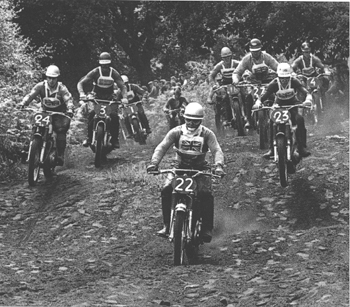 In 1961 there where eleven rounds in: Switzerland, Austria, France, Czechoslovakia, Italy, Great Britain,
Holland, Belgium, Sweden, Luxembourg and Germany. Sweden continued their domination and was about to do just
that for several seasons to come. The results where:
1: Sten Lundin, Sweden (Lito).
2: Bill Nilsson, Sweden (Husqvarna).
3: Gunnar Johansson, Sweden (Lito).
In 1961 there where eleven rounds in: Switzerland, Austria, France, Czechoslovakia, Italy, Great Britain,
Holland, Belgium, Sweden, Luxembourg and Germany. Sweden continued their domination and was about to do just
that for several seasons to come. The results where:
1: Sten Lundin, Sweden (Lito).
2: Bill Nilsson, Sweden (Husqvarna).
3: Gunnar Johansson, Sweden (Lito).
The 1962 season didn't have a German round so there where just ten rounds. The Sweds where just as dominating as the previous years. Rolf Tibblin, the 1958 250cc champion that only managed fifth place the year before had fully adopted to the heavier machinery to take the crown. The fourth and fifth place where taken by Sweds as well. 1: Rolf Tibblin, Sweden (Husqvarna). 2: Gunnar Johansson, Sweden (Lito). 3: Sten Lundin, Sweden (Lito).
In 1963 there where twelve rounds with new races in Denmark, Russia (Soviet union) and DDR. But unfortunately for the Swedish audience no round in Sweden despite the obvius success for their riders. 1: Rolf Tibblin, Sweden (Husqvarna). 2: Sten Lundin, Sweden (Lito). 3: Jeff Smith, Great Britain (BSA).
In 1964 the series has grown to include fourteen rounds, Sweden was back, so was Germany and Spain was new. The amazing Jeff Smith not only cracked the list looking like a Swedish national standing but he even managed to overtake them all on the new lightweight (228Ib, 102kg) BSA which was about 80Ib (36kg) lighter than Rolf Tibblins Hedlund. 1: Jeff Smith, Great Britain (BSA). 2: Rolf Tibblin, Sweden (Hedlund). 3: Sten Lundin, Sweden (Lito).
1965 there was thirteen rounds and the Swedish dominance was about to diminish and wasn't about to return for another five years with new riders on new machines. 1: Jeff Smith, Great Britain (BSA). 2: Paul Fredrichs, DDR (CZ). 3: Rolf Tibblin, Sweden (CZ).
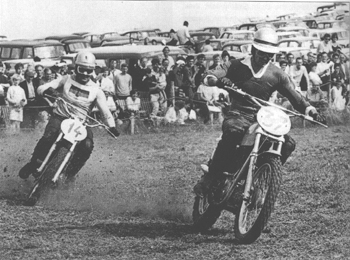 In 1966 there where fourteen rounds again. The eastern brands CZ and Jawa where very succesful during this period.
1: Paul Fredrichs, DDR (CZ).
2: Rolf Tibblin, Sweden (CZ).
3: Jeff Smith, Great Britain (BSA).
In 1966 there where fourteen rounds again. The eastern brands CZ and Jawa where very succesful during this period.
1: Paul Fredrichs, DDR (CZ).
2: Rolf Tibblin, Sweden (CZ).
3: Jeff Smith, Great Britain (BSA).
1967 there where only eleven rounds with no Swedish riders in top six at all. One of the greatest riders ever, Roger de Coster placed himself in the standings in fifth place. 1: Paul Fredrichs, DDR (CZ). 2: Jeff Smith, Great Britain (BSA). 3: Dave Bickers, Great Britain (CZ).
The 1968 season was made up by thirteen rounds. Husqvarna was back in the results and so where a few brand new Swedes. The dominant Eastern Germany rider Paul Fredrichs took his CZ to the third gold in a row and with a silver the year before that (1965) he is forever to be recognized as on of the greatest. 1: Paul Fredrichs, DDR (CZ). 2: John Banks, Great Britain (BSA). 3: Åke Johnsson, Sweden (Husqvarna).
The last season of the decade, 1969, had eleven rounds. The final result was: 1: Bengt Åberg, Sweden (Husqvarna). 2: John Banks, Great Britain (BSA). 3: Paul Fredrichs, DDR (CZ).
250GP 1960 - 1969 European/World Championship
In 1960 the 250GP had European Championship status. There where twelve rounds in Switzerland, Belgium, France, Chechoslovakia, Poland, Italy, DDR, Finland, Luxembourg, Great Britain, Sweden and Germany. The final score was: 1: Dave Bickers, Great Britain (Greeves). 2: Jeff Smith, Great Britain (BSA). 3: Miroslav Souchek, Czechoslovakia (Eso).
The 1961 season was the last European Championship. The cicuit had thirteen rounds, one new in the former soviet union that added up the twelve rounds from the year before. Great Britain riders where dominant, altough the Brittish didn't had much interest in the quarter litre class before. Greeves was a succesful and popular Brittish brand and was probably the closest thing to a modern light weight two-stroke motocross bike manufactured by the Brittish motorcycle industry before it diminished. The final standing was 1: Dave Bickers, Great Britain (Greeves). 2: Arthur Lampkin, Great Britain (BSA). 3: Jeff Smith, Great Britain (BSA).
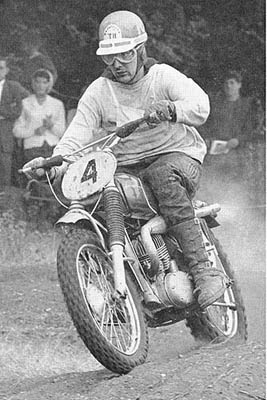
In 1962 The 250cc class got official World Championship status. The series where rather long and had as much as fifteen rounds in respectively: Spain, Switzerland, Belgium, France, Russia (Soviet union), Poland, Holland, Luxembourg, Finland, Germany, Italy, Great Britain, Sweden (Enköping), DDR (East Germany) and Czechoslovakia. The Russian GP in St Petersburg (Yukki) was whitnessed by over 100,000 spectators according to many sources. The seven best results where counted per rider and thus, technically two riders could score full points. In the event that two riders had the same points the positions in the eight, ninth and so on would be used to detemine the placings. Artur Lampkin won the first round in Spain. Jeff Smith won the second and then Lampkin the third again. In mid season Jeff Smith had 40 points and looked to win the championship when the Swede, Torsten Hallman made his move. Within a month he had taken over the lead and clinced the title as early as in his home GP in Enköping, Sweden. The final standing where 1: Torsten Hallman, Sweden (Husqvarna). 2: Jeff Smith, Great Britain (BSA). 3: Arthur Lampkin, Great Britain (BSA).
1963 season had fourteen rounds, the seven best where still counted. The final standings where 1: Torsten Hallman, Sweden (Husqvarna). 2: Vlastimil Valek, Czechoslovakia (CZ). 3: Igor Grigoriev, Russia (CZ).
In 1964 there where still fourteen rounds and the seven best counted for the final standings. This was the first season that the legendary Belgian Joel Robert won a championship. He was about to have a major impact on the sport into the 70's. 1: Joel Robert, Belgium (CZ). 2: Torsten Hallman, Sweden (Husqvarna). 3: Victor Arbekov, Russia (CZ).
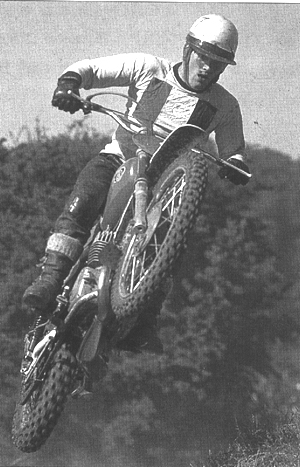 in 1965 there where fifteen rounds again but still the best seven to counts. In the end the final standings where
1: Victor Arbekov, Russia (CZ).
2: Joel Robert, Belgium (CZ).
3: Dave Bickers, Great Britain (Greeves).
in 1965 there where fifteen rounds again but still the best seven to counts. In the end the final standings where
1: Victor Arbekov, Russia (CZ).
2: Joel Robert, Belgium (CZ).
3: Dave Bickers, Great Britain (Greeves).
In 1966, fifteen rounds but the best eight to be counted. The final standings where 1: Torsten Hallman, Sweden (Husqvarna). 2: Joel Robert, Belgium (CZ). 3: Petr Dobry, Czechoslovakia (CZ).
1967 season had only twelve rounds, once again only the seven best to count. Torsten Hallman, the founder of the famous THOR Racing became the first to win three titles. To be honest some of the success probably relied on several injuries that inflicted the Belgium rider Joel Robert. Both sholder and foot injuries kept him from beeing able to do himself justice. The final standing where however 1: Torsten Hallman, Sweden (Husqvarna). 2: Joel Robert, Belgium (CZ). 3: Olle Petterson, Sweden (Husqvarna).
In 1968 there where fourteen rounds again, best seven to count though. To be noticed is perhaps that Yugoslavia was a newcomer in racing and hosted a round. The title winner Joel Robert won the title with only two points of margin. The standings ended up with 1: Joel Robert, Belgium (CZ). 2: Torsten Hallman, Sweden (Husqvarna). 3: Sylvain Geboers, Belgium (CZ).
The 1969 was the last season of the decade and they had twelve rounds. To be noticed is that Olle Petterson rode a Suzuki. The Japanese Suzuki factory was determined to fight the other brands and hired the GP rider from Hedemora in Sweden to do the test riding and development for them. The Suzuki where able to build a very light machine and had some success from the early beginning. The final points standing where 1: Joel Robert, Belgium (CZ). 2: Sylvain Geboers, Belgium (CZ). 3: Olle Petterson, Sweden (Suzuki).
Motocross Des Nations 500cc 1960 - 1969
The 1960 edition of MX Des Nations where in France (Cassel) the fourth of September. The horrific conditions lead to that only Great Britain qualified for a result and therefore where declared winners. Their team was Don Rickman (Metisse), Jeff Smith (BSA) and Dave Curtis (Matchless).
1961 27 August in Schijndel, Holland. The weather was beautiful and most riders seemed to like the sandy track. The Swedish team was nearly cheated on their gold since the arranger allowed a false start. Ove Lundell stayed on the starting block waiting for a restart and Rolf Tibblin wasn't even lined up. As soon as they understood that the race wasn't going to be stopped they went away chasing the field. They caught the field but kept their unrealistic speed and carried the team to the victory. The riders where Bill Nilsson (Husqvarna), Rolf Tibblin (Husqvarna) and Ove Lundell (Monark). Great Britain came in as second with Jeff Smith (BSA), Dave Curtis (Matchless) and Leslie Archer (Norton). France managed third with René Klym (BSA), Gérard Ledormeur (BSA) and M Beaumard (BSA).
In 1962, Switzerland (Zürich-Wohlen) the 26 August all familiar countries and their riders slammed into each other again. The Swedes showed up a crushing dominance and they even did put up somewhat of a show as four Sweds crossed the finishing line together in the final. The desicion was made that since it was a team competititon and Sweden clearly won no individual winner was declared. The riders Rolf Tibblin (Husqvarna), Gunnar Johansson (Lito), Ove Lundell (Monark) and Bill Nilsson (Lito) crossed the line together. However the winning team only included Tibblin, Lundell and Johansson. The Brittish team with Derek Rickman (Metisse), Don Rickman (Metisse) and Jeff Smith (BSA) took second. In third was Belgium with Huber Scaillet (BSA), Herman de Soete (Matchless) and Walter Baeten (Eso).
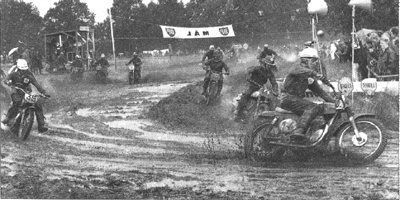 The 25 August 1963 at Ring Knutstorp in Sweden the next MX des Nations where held. There where new scoring methods
as there where no finals. Instead the three best results in two heats where added together. Thus more than three riders
could be included in the team. Infact if three riders where altogether better than three others in each of the heats
a team could very well be made up by six different riders.
Great Britain won with Don Rickman (Metisse), Derek Rickman (Metisse), Jeff Smith (BSA again) and John Burton (BSA).
Sweden got second place with Sten Lundin (Lito), Per-Olaf Persson (Monark), Ove Lundell (Monark) and Jan Liljedahl (Husqvarna).
Belgium was third with Herman de Soete (Eso), Hubert Scaillet (Metisse), F Slechten (AJS) and Roger Vanderbecken (Triumph).
The 25 August 1963 at Ring Knutstorp in Sweden the next MX des Nations where held. There where new scoring methods
as there where no finals. Instead the three best results in two heats where added together. Thus more than three riders
could be included in the team. Infact if three riders where altogether better than three others in each of the heats
a team could very well be made up by six different riders.
Great Britain won with Don Rickman (Metisse), Derek Rickman (Metisse), Jeff Smith (BSA again) and John Burton (BSA).
Sweden got second place with Sten Lundin (Lito), Per-Olaf Persson (Monark), Ove Lundell (Monark) and Jan Liljedahl (Husqvarna).
Belgium was third with Herman de Soete (Eso), Hubert Scaillet (Metisse), F Slechten (AJS) and Roger Vanderbecken (Triumph).
1964, 26 August in Great Britain (Hawkstone Park) the next MX des Nations where held ant the result was Great Britain in first place with team members Jeff Smith (BSA), Derek Rickman (Metisse), Don Rickman (Metisse) and Vic Eastwood (Matchless). Belgium took second spot with Herman de Soete (Metisse), Sylvain Geboers (Metisse), Hubert Scaillet (Metisse) and Roger Vanderbecken (Triumph). Holland managed to take third. The riders in the team where Broer Dirks (Lito), J Heyboer (BSA), B Hartleman (BSA), Peter Dirks (Lito) and R Boom (Husqvarna).
In 1965, 30 August, the MX des Nations where held at the classical Namur track in Belgium. Great Britain where in the middle of their winning streak and took the title for the third consecutive year with their riders Don Rickman (Metisse), Jeff Smith (BSA), Vic Eastwood (BSA) and Arthur Lampkin (BSA). Belgium who was set to repeat their 1951 win after fourteen years of waiting and as a matter of fact nine podium results during that time, had to give in for the Brittish steel once again. Their new rising star Joel Robert was the man who was supposed to drag the hard earned title back home and he did by all means his best with individual wins in both the heats. Unfortunately the rest of the team couldn't match the Brittish team. Belgiums team riders where Joel Robert (CZ), Herman de Soete (Metisse), Jef Teuwissen (Metisse) and Sylvain Geboers (Metisse). Switzerland got third with Pierre André Rapin (Monark), H Fischer (Hedlund), M von Arx (Monark) and F Thevenaz (Metisse). Another interesting fact is that the Swedish team didn't have one single rider within top six in either heat even though there where three Swedes among the six best riders in the individual 500 GP and as such should indeed have won the whole thing. That´s racing !
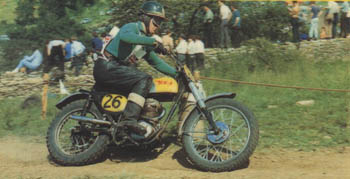 France hosted the 1966 event at Remelard in 28 August. Great Britain couldn't be stopped and took the title for the
fourth year in a row with Dave Bickers (CZ), Don Rickman (Metisse), Arthur Lampkin (BSA) and Vic Eastwood (BSA).
The CZ mounted Belgium team was second once again with Joel Robert (CZ), Roger de Coster (CZ), Walter Baeten (CZ), Jef Teuwissen (CZ)
and Sylvain Geboers riding a Swedish Lindström.
Sweden Was third with Torsten Hallman (Husqvarna), Bill Nilsson (Husqvarna), Åke Jonsson (Husqvarna) and Gunnar Johansson (CZ).
France hosted the 1966 event at Remelard in 28 August. Great Britain couldn't be stopped and took the title for the
fourth year in a row with Dave Bickers (CZ), Don Rickman (Metisse), Arthur Lampkin (BSA) and Vic Eastwood (BSA).
The CZ mounted Belgium team was second once again with Joel Robert (CZ), Roger de Coster (CZ), Walter Baeten (CZ), Jef Teuwissen (CZ)
and Sylvain Geboers riding a Swedish Lindström.
Sweden Was third with Torsten Hallman (Husqvarna), Bill Nilsson (Husqvarna), Åke Jonsson (Husqvarna) and Gunnar Johansson (CZ).
1967, 2 September in Holland (Markelo). Great Britain took their fifth MX des Nations title clearly ahead of Sweden and Belgium. The Brittish riders where Vic Eastwood (BSA), Dave Bickers (CZ) and Jeff Smith (BSA). The Swedish riders that managed third was Torsten Hallman (Husqvarna), Åke Jonsson (Husqvarna) and Olle Pettersson (Husqvarna). The Belgium team where made up of Joel Robert (CZ), Roger de Coster (CZ), F Slechten (CZ) and Jef Teuwissen (CZ). The two Swedes Åke Jonsson and Olle Pettersson came to play roles in the bigger picture later on. Åke as a major World GP contender riding Maico and Olle for developing and bringing Suzuki into the world motocross arena.
The 1968 event took place in Russia (Sovjet union), Kishinev the 14 September. The final result of the event isn't altogether clear since most countries didn't participate as a protest for the Sovjet invasion of Czechoslovakia. The records is not comprehensive enough and there is no english language spoken eye whitness of the event at all. However the results states that Sovjet Union won the competition with the riders: Evgeni Petushkov (CZ), Leonid Shinkarenko (CZ), Arnis Angers (CZ) and Vladimir Pogrebynak (CZ). Second where DDR with Paul Friedrichs (CZ), Helmut Schadenberg, H Fischer, Heinz Hoppe. Third was France with Bacou (Bultaco), Joël Queirel (Husqvarna), José Barbara (BSA), Lenoir (CZ), Avronsart (CZ).
In 1969, 7 September, Great Britain (Farleigh Castle) the last MX des Nations where held. Finally the Belgium team was able to win the title and document themselves as one of the best teams throughout the entire 60's. No other team deserved this victory as much as the Belgian team did. Another fact is that they won in Great Britain against all the best countries and riders available. The heroic riders where Roger de Coster (CZ), Joel Robert (CZ), Jef Teuwissen (Husqvarna) and Sylvain Geboers (CZ). Sweden had to settle for second with Bengt Åberg (Husqvarna), Arne Kring (Husqvarna), Torsten Hallman (Husqvarna) and Åke Jonsson (Maico). Great Britain ended an extraordinary successful decade by taking third with John Banks (BSA), Dave Bickers (CZ), Jeff Smith (BSA) and Keith Hickman (BSA).
Trophee Des Nations 250cc 1961 - 1969
The Trophee des Nations started in 1961 due to the rising interest in the 250cc class. Great Britain won the event despite their pale interest for the quarter litre class just a few years earlier. The Brittish riders where: Dave Bickers (Greeves), Arthur Lampkin (BSA) and Jeff Smith (BSA). Not too surprising though since these three men took all podium places in the 250cc GP final standings. Second was Sweden with Torsten Hallman (Husqvarna), Sivert Eriksson (Husqvarna) and Stig Rickardsson (Husqvarna). Stig Rickardsson is actually the father of one of the most successful speedway riders in the 90's and 21'th century, Tony Rickardsson with several individual World championship golds.
In 1962, Great Britain where once again the Trophee des Nations winners with the same team: Dave Bickers (Greeves), Arthur Lampkin (BSA) and Jeff Smith (BSA).
The 1963 event in Belgium (Lac de Loppem/Bruges) was won by Sweden with Lars Forberg (Husqvarna), Torsten Hallman (Husqvarna) and Cenneth Lööf (Husqvarna).
1964 Sweden repeated their win with Torsten Hallman (Husqvarna), Åke Jonsson (Husqvarna) and Olle Pettersson (Husqvarna).
The 1965 event was cancelled due to bad riding conditions. Great Britain won the first heat but the competition couldn't be completed. No winner was declared.
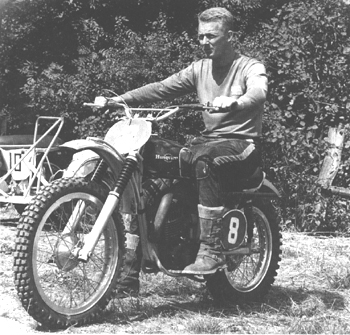 1966 Sweden continued to dominate the quarter litre class with yeat another Tropheé win. The riders where:
Torsten Hallman (Husqvarna), Olle Pettersson (Husqvarna) and Åke Törnblom (CZ).
1966 Sweden continued to dominate the quarter litre class with yeat another Tropheé win. The riders where:
Torsten Hallman (Husqvarna), Olle Pettersson (Husqvarna) and Åke Törnblom (CZ).
br> The 1967 event became no different in the perspective of who's won. Sweden had a number of very strong riders and Husqvarna had very competitive bikes, infact the 250cc model released in 1966 where likely the best machine at the time. The 1967 riders where Staffan Eneqvist (Husqvarna), Torsten Hallman (Husqvarna), Olle Pettersson (Husqvarna) and Åke Jonsson (Husqvarna).
Sweden took the title once more in 1968. The interesting fact here is that the Swedish team switched some team members almost every year. The saying in Sweden those days was that the Swedish nationals (SM) was just as hard as the GP circuit. However the riders where: Bengt Åberg (Husqvarna), Bengt-Arne Bonn () and Christer Hammargren (Husqvarna). Strangely enough Bengt Åberg and Christer Hammargren where 500cc GP riders. Bengt-Arne Bonn where National champion in 1968 but Torsten Hallman, Håkan Andersson and Olle Pettersson where still considered better 250 riders in an international context. One can wonder about how this team came about ?
The 1969 event was won by Belgium. This victory was the first in a ten year dominance that was about to come. In a way Belgium took over from Sweden as the leading nation and wasn't about to give it back. The riders where, please sit down: Roger de Coster (CZ), Sylvain Geboers (CZ) and Joel Robert (CZ).
Europe enduro championship 1968 - 1969
The Europe enduro championship started in 1968. The 50cc winner where Volkern Kramer, Germany (Zündapp). H Trinkner, Germany won the 75cc class. S Giengier, Germany 100cc. Rolf Witthöft, Germany (Hercules) 125cc. Peter Uhlig, DDR 175cc. Werner Salevsky, DDR 250cc. Kvetoslav Masita, Czechkoslovakia 350cc. Erwin Schmider, Germany +350cc.
1969 the individual winners where: Heinz Brinkmann, Germany 50cc. Andreas Brandl, Germany (Zündapp) 75cc. Volkern Kramer,Germany (Zündapp) won the 100cc class. Rolf Witthöft, Germany (Hercules) 125cc. W Leitgeb, Austria 175cc. Frantizek Mrázek, Czechkoslovakia 250cc. Kvetoslav Masita, Czechkoslovakia 350cc. Erwin Schmider, Germany +350cc.
ISDT 1960 - 1969
| Year | Trophy | Silver Vase |
| 1960 |
Austria  |
Italy  |
| 1961 |
Germany  |
Czechkoslovakia  |
| 1962 |
Czechkoslovakia  |
Germany  |
| 1963 |
DDR  |
Italy  |
| 1964 |
DDR  |
DDR  |
| 1965 |
DDR  |
DDR  |
| 1966 |
DDR  |
Germany  |
| 1967 |
DDR  |
Czechkoslovakia  |
| 1968 |
Germany  |
Italy  |
| 1969 |
DDR  |
Germany  |
Great Britain (Llandrindod Wells) in 1961. Germany won the Trophy and Czechoslovakia won the Silver vase.
In 1962 the event took place in Germany (Garmisch-Partenkirchen). Czechoslovakia won the Trophy and Germany won the Silver vase.
1963 in Czechoslovakia (Spindleruv Mlyn) DDR won the Trophy and Italy the Silver vase. The DDR team all rode MZ under the team boss Walter Winkler. The DDR riders where Werner Salevsky, Horst Lohr, Bernd Uhlmann. Peter Uhlig. Günter Baumann and Hans Weber
1964 in DDR (Erfurt) The DDR teams won both the Trophy and the Silver Vase on home ground. That year 226 riders from 13 countries participated.
Great Britain hosted the 1965 event in Isle of Man. There where 299 riders from 17 countries. DDR once again won both the Trophy and the Silver vase.
1966 in Sweden (Örebro) DDR won the Trophy and their rivals from the west, Germany won the Junior Silver Vase.
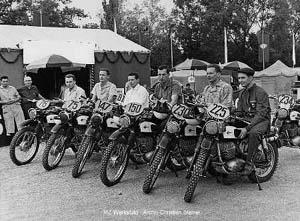 The 1967 event was held in Poland (Zakopane). DDR won the Trophy and Czechoslovakia the Silver vase.
The 1967 event was held in Poland (Zakopane). DDR won the Trophy and Czechoslovakia the Silver vase.
1968 in Italy (San Pellegrino) Germany won the Trophy and Italy, the home nation won the Silver vase.
1969, the last ISDT of the decade was hosted in Germany (Garmisch-Partenkirchen). There where 321 riders from 17 countries. DDR won the Trophy once again with Peter Uhlig, Klaus Halser, Werner Salevski, Klaus Teuchert, Karlheinz Wagner, Fred Willamowski and team manager Walter Winkler. Germany won the Silver vase.
MX in the 60's
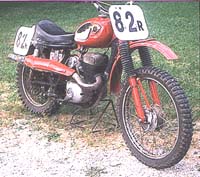 The 60's started out much like the 50's ended with the same bikes and riders. Bill Nilsson went on to grab a hold on the
500GP championship again 1960, this time on a Husqvarna. Sten Lundin went out for revenge and
claimed the 1961 500GP title on his Lito. Another rising Swedish star, Rolf Tibblin watched the battle and
figured he might as well beat both of them, he laid his hands on both the 1962 and 1963 season
The 60's started out much like the 50's ended with the same bikes and riders. Bill Nilsson went on to grab a hold on the
500GP championship again 1960, this time on a Husqvarna. Sten Lundin went out for revenge and
claimed the 1961 500GP title on his Lito. Another rising Swedish star, Rolf Tibblin watched the battle and
figured he might as well beat both of them, he laid his hands on both the 1962 and 1963 season
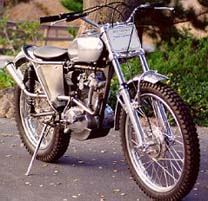 aboard his mighty Husqvarna. Finally Great Britains Jeff Smith took his BSA to the
champions circle in 1964 and 1965, more than 11 years after going with BSA. In 1966 Jeff Smith
accidently ended Ove Lundell's carreer in a collision where Lundell got off his bike at the
wrong time and place, his bike had stopped. East-German Paul Friedrichs took the title 1966
aboard a CZ. He managed to repeat that both in 1967 and 1968 while another Swede, Bengt Aberg
took the 1969 title on a Husky, of course.
aboard his mighty Husqvarna. Finally Great Britains Jeff Smith took his BSA to the
champions circle in 1964 and 1965, more than 11 years after going with BSA. In 1966 Jeff Smith
accidently ended Ove Lundell's carreer in a collision where Lundell got off his bike at the
wrong time and place, his bike had stopped. East-German Paul Friedrichs took the title 1966
aboard a CZ. He managed to repeat that both in 1967 and 1968 while another Swede, Bengt Aberg
took the 1969 title on a Husky, of course.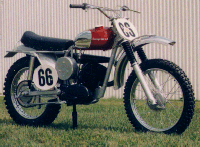 The Husqvarna 250 1966 was the lightest, fastest and
most modern bike. It was imported to USA along with 10 Husky 360's. The success was immidiate
through riders like: John Penton, Malcolm Smith, Dub Smith, JN Roberts and Torsten Hallman
who also won the World Championship 250 class in 1966 and 1967.
The Husqvarna 250 1966 was the lightest, fastest and
most modern bike. It was imported to USA along with 10 Husky 360's. The success was immidiate
through riders like: John Penton, Malcolm Smith, Dub Smith, JN Roberts and Torsten Hallman
who also won the World Championship 250 class in 1966 and 1967.The 1968 Husqvarna 250 Hallman Replica had some minor updates, a new frame design, some minor chassie details and a few upgrades in the engine internals. This package attracted: Malcolm Smith, John Penton, JN Roberts, Whitey Martino, Torsten Hallman, Gunnar Lindstrom, Arne Kring, Christer Hammargren, Rolf Tibblin, Vic Eastwood, Brian Goss and Staffan Eneqvist. Most of these names are true legends known for developing the sport and also bringing it to the USA. While Husky was the big name, German brand Maico continued to produce nice but somewhat odd design solution bikes, 250'a and in the late 60's a 360cc bike. The bike came in a motocross and an enduro version. These bikes scored good points in the magazines that tested them, something was about to come.
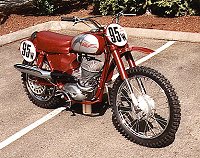 1963 Jawa released their new typ 579 at 250cc and 350cc two-strokes. They where lighter and faster than
the typ 557 they replaced. 1964, 1965 and 1966 Jawa struggled with the "banana frame" production
bike. Vlastimil Valek and Peter Dobry raced the bikes and Valek best managed to keep the brand
appearing on the GP scene during this time. The last season of the "banana frame" bike Valek
raced a 402cc bike in the 500GP managing to take 4´th place in the final standings. Jawa switched
to a dual tube conventional frame design. Jaroslav Homola finished 10'th in the 500cc
world standings on this 420cc Jawa in 1969.
1963 Jawa released their new typ 579 at 250cc and 350cc two-strokes. They where lighter and faster than
the typ 557 they replaced. 1964, 1965 and 1966 Jawa struggled with the "banana frame" production
bike. Vlastimil Valek and Peter Dobry raced the bikes and Valek best managed to keep the brand
appearing on the GP scene during this time. The last season of the "banana frame" bike Valek
raced a 402cc bike in the 500GP managing to take 4´th place in the final standings. Jawa switched
to a dual tube conventional frame design. Jaroslav Homola finished 10'th in the 500cc
world standings on this 420cc Jawa in 1969.Typically the engines during the 60's where rather weak compared to later models. 250cc two-strokes gave between 20 and 28 bhp, the popular 350-360cc size threw out around 30-35bhp. The front suspension travel was around 6" (150mm) in the middle of the 60´s and barely made it towards 7.5" (190mm) at the end of the decade. The rear suspension offered just about 3-4" (90mm) of travel at this time.
Pictures, spec's and books about 60´s.